Are you looking for a list of animals that starts with Y? Below is a complete list of animal names that start with the letter Y for your enjoyment or use.
Are you a teacher looking for interesting information that you could use in the classroom to teach children about animals?
Or maybe you are a nature-loving parent who wants to show his/her kids how generous and diversified nature is?
No matter your needs, this post will provide you not only with a list of 20 animals that start with the letter Y but also with interesting information about each one of them.
But enough idle talk. Let’s get down to business!
Animals that start with Y
Yabby
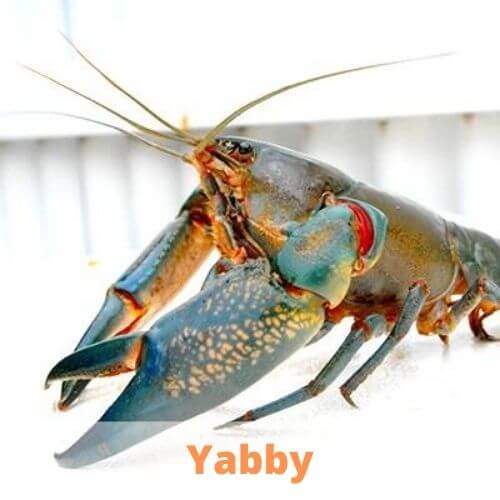
Yabbies are Australian freshwater crustaceans that can be found in dams, rivers, and streams.
Yabbies are invertebrate arthropods. That means that they have jointed legs and do not have backbones.
In exchange, yabbies have hard outer shells that function like armours that protect their bodies. Since the outer shell doesn’t grow, yabbies moult multiple times, especially when young and growing.
Depending on the water they live in (clear or muddy), the colours of yabbies can range from brown to green or pale blue.
After they moult, the colour of the new shell matches the water they live in. Yabbies are detrivores and they feed mainly on plant remains and algae.
However, if they have the opportunity, they also feed on animal and fish remains.
Basically, they are scavengers. Yabbies can survive both in very cold and very hot conditions by lying dormant.
Since they don’t need to stay in the water all the time, they can travel large distances (up to 60 km) in search of new waters to live in.
Since Australians highly appreciate their meat, catching yabbies has turned into a popular summertime activity.
Yak
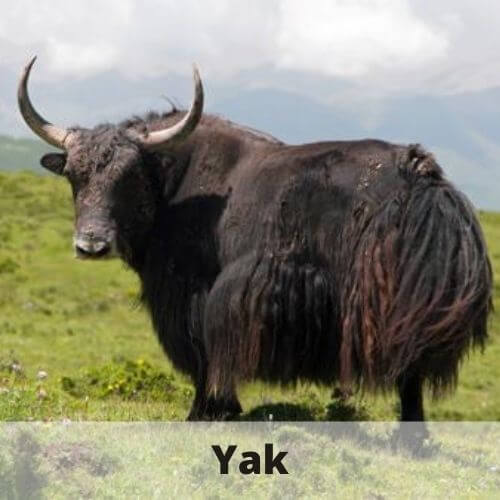
Close relatives of bisons and buffalos, yaks are highly appreciated for their meat, milk, and fur.
We can distinguish between two species of yaks: wild and domesticated. Wild yaks inhabit the Asian steppes and alpine meadows.
90% of both species inhabit the Tibetan Plateau in the Himalayas. Due to excessive hunting and habitat loss, wild yaks are considered a vulnerable species.
Yaks are herbivores and feed on grass, wild flowers, mosses, and even lichens, thus playing a crucial role in the alpine ecosystem.
Thanks to their dense horns, yaks are able to break through ice and snow and reach the plants underneath.
They also use their horns against predators such as Himalayan wolves, snow leopards, or brown bears.
Since yaks live at high altitudes and need to survive low temperatures (sometimes lower than -40º C), their bodies are protected by thick, wooly coats.
Yaks live in herds that can reach up to several hundred individuals. However, most of the herds are smaller and they consist mostly of females and their calves.
To protect themselves from the cold (during snowstorms or at night), yaks huddle up and keep calves in the centre.
Wild yaks live around 20 years, while domesticated yaks can live a little longer.
Interesting facts about yaks
- No other mammal lives at a higher altitude than yaks.
- Their dung is usually used as fuel.
- Yaks have been playing a crucial role in the survival of the inhabitants of the Tibetan Plateau.
Due to their sturdiness and stability, yaks are known as the ‘boats of the plateau’, being able to carry heavy loads across mountain passes.
What’s more, their meat is rich in proteins, helping nomads and Tibetan Buddhists survive harsh conditions. - Their fur is a renewable and sustainable fibre, highly appreciated for its warm, silky, and soft texture. A rare and natural fibre that is even more sustainable than the famous cashmere.
- Their milk can be consumed as such or used to make butter, yoghurt, or cheese.
Yellow Ground Squirrel

A large and sturdy ground squirrel species, the yellow ground squirrel can be found in Russia, Uzbekistan, Afghanistan, Turkmenistan, China, and Iran.
Even though the habitat of these terrestrial rodents mainly consists of clay, sand, and loess semi-deserts and desserts, they can also be found in certain forest zones. Yellow ground squirrels live around 5-6 years.
Yellow ground squirrels are herbivores, feeding on desert vegetation such as leaves, stems, bulbs, and seeds. Once the period of vegetation ends, yellow ground squirrels hibernate.
Interesting facts about Yellow Ground Squirrel
- In 24 hours, a yellow ground squirrel eats around 275 grams of vegetation. As soon as the sun rises, the squirrel leaves the burrow and starts eating the vegetation nearby.
As the day warms, it will return to the burrow until late afternoon when it will come out again for the last meal of the day. - Burrows are excavated close to each other. And there is a good reason for it: it is easier to hear their neighbour’s alarm calls when a predator attacks. Their biggest enemies are eagles and polecats.
However, polecats hunt mainly young squirrels. In order to discourage polecats, young squirrels try to mimic the pitch of the adults’ alarm call.
Yellowhammer
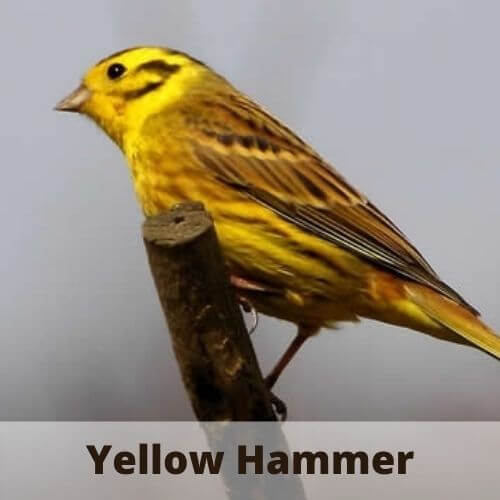
Yellowhammers are partially migratory songbirds closely related to the bunting family.
Though they are native to Eurasia, they can also be found in Australia and New Zealand. While most of the European subspecies don’t migrate, the eastern ones spend winter further south.
In wintertime, they gather in large flocks (together with sparrows, buntings, and finches) and stay close to farms to get food.
Yellowhammers usually inhabit farmlands, forest edges, pastures, hedgerows, thickets, or scrublands.
They are active during the day and gather in large flocks at night. Yellowhammers are omnivores, eating both plants and insects.
Even though cereals and grains play a crucial role in their diet (especially in autumn and winter), yellowhammers won’t say no to springtails, grasshoppers, beetles, caterpillars, flies, spiders, or snails either.
Yellowhammers have yellow bodies, orange chests, and streaked brown backs.
Their rumps are reddish-brown and they have a long, forked tail. Males boast brighter colours than females.
Females use moss and grass to build cup-shaped nests directly on the ground or close to it.
Apart from birds of prey, yellowhammers have other enemies – such as corvids or rodents – who feast on their eggs.
Interesting facts about the Yellow Hammer
- Females choose their lifetime mating partners based on their singing abilities. Even though their songs are rather monotonous, males learn them from their fathers.
- Even if only the female incubates the eggs, both parents feed their chicks.
- Young yellowhammers are ready to fly when they are only 14-16 days old.
Yellowjacket
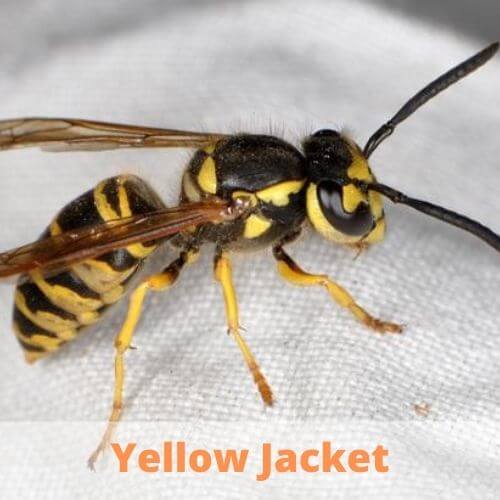
Commonly known as wasps, yellowjackets are predatory insects that build nests that house large colonies.
Easily mistaken with bees due to their size and colours, yellowjackets are black and present yellow markings on the head and around the abdomen.
Abundant worldwide, yellowjackets are carnivorous, feeding mainly on insects such as flies or bees. But they also enjoy fruits and nectar.
When a honey bee stings, its stinger comes out. In the case of yellowjackets, the stinger doesn’t come out, allowing them to sting multiple times.
Stinging is a defensive mechanism they won’t hesitate to use to protect the nest. The good news is that only female yellowjackets sting.
Interesting facts about the Yellow Jacket
- While the role of the queen is to stay in the nest and lay eggs, workers build the nest, protect it, and bring in food for the brood and the queen.
As soon as the egg is laid, the queen fertilizes it. However, the queen doesn’t always fertilize all the eggs, allowing non-fertilized eggs to develop into male drones.
A mature yellowjacket colony is made up of the queen, the brood, infertile female workers, reproductive females, and males. - Only queens survive the winter.
- Since they feed on insects that may otherwise damage crops, yellowjackets should not be killed.
Yellow Mongoose

Found in South Africa, the yellow mongoose lives in open, semi-arid areas (ex. scrublands, grasslands).
Generally quiet and solitary animals, yellow mongooses live in burrows either alone or in pairs.
Thanks to their strong and curved claws, they are excellent diggers. Mainly active during the day, yellow mongooses feed mainly on insects.
However, amphibians, bird eggs, rodents, and reptiles are also part of their diet. But they also have enemies such as jackals, snakes or birds of prey.
Interesting facts about Yellow Mongoose
- Yellow mongooses are very creative. They are known for using their forepaws to throw bird eggs against rocks or other hard objects to break them open.
- They can dig their burrows up to 1.5 meters deeps. Their burrows are large and have multiple entrances, tunnels, and chambers.
- They use scent to demarcate their territories but also to signal their reproductive status.
- Yellow mongooses help regulate the rodent and insect populations.
- Yellow mongooses carry rabies, infecting other animals.
Yellow-Backed Duiker
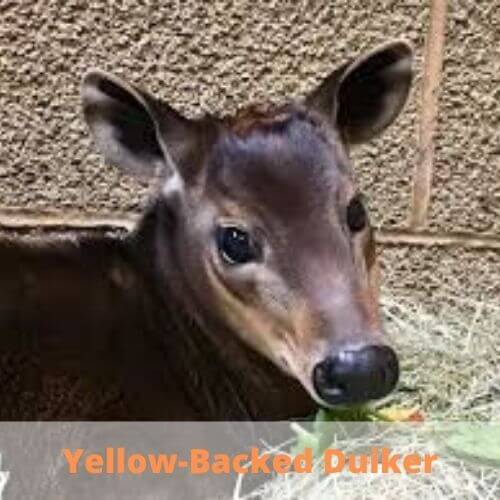
Mainly found in Western and Central Africa, yellow-backed duikers are antelopes that mainly live in forests.
However, they can also be found in savanna clearings and open bush. We are talking about the largest duiker species, easily recognizable by the triangular yellow patch on their back.
They usually live alone or in couples. Yellow-backed duikers feed mainly on fruits, plants, seeds, and leaves. But they also eat small animals such as ants, birds, or lizards. Leopards and lions are their biggest enemies.
Interesting facts about Yellow Backed Duiker
- Due to overhunting, yellow-backed duikers are currently considered a nearly endangered species. They are especially easy to hunt at night. Hunters use torchlights to scare them and make them freeze.
- They use the scent glands near their eyes to demarcate their territories, communicate with other duikers, and signal their reproductive status.
- Yellow-backed duikers help to disperse the seeds of a wide range of plants.
Yellow Baboon

Yellow baboons belong to the Old World monkeys family and are easily identifiable by their yellow-brown fur and dog-like shape of their heads and muzzles (T-shaped).
Their faces are hairless, black, and are framed with white sideburns. Their tails can grow almost as long as their bodies.
Yellow baboons live around 20-30 years. Primarily found in Eastern Africa, yellow baboons inhabit light forests and savannas.
They live in large, gender-mixed groups. Even though they prefer fruits, they also feed on seeds, grass, plants, leaves, fungi, insects, rodents, worms, and other small animals.
Generally, yellow baboons are ground-dwelling, diurnal animals. Foraging for food and socializing are, beyond any doubt, their favourite activities.
Interesting facts about Yellow Baboons
- Yellow baboons live in large groups based on hierarchies. The highest-ranking members benefit from more food and even more mating opportunities.
Making alliances is not uncommon. Males may team up with other males to defeat a stronger male. - The members of the group sleep, travel, and forage together.
- While males may choose to emigrate from the natal group, females prefer stability.
- Yellow baboons are very sociable and have developed a complex form of communication. From friendly to threatening gestures, vocalizations, and auditory cues such as grinding, yellow baboons are great communicators.
- Yellow baboons play a crucial ecological role, dispersing the undigested seeds or carrying fruit away from trees.
Since they dig for tubers and roots, they also play an important role in soil aeration.
Yellow-Bellied Marmot
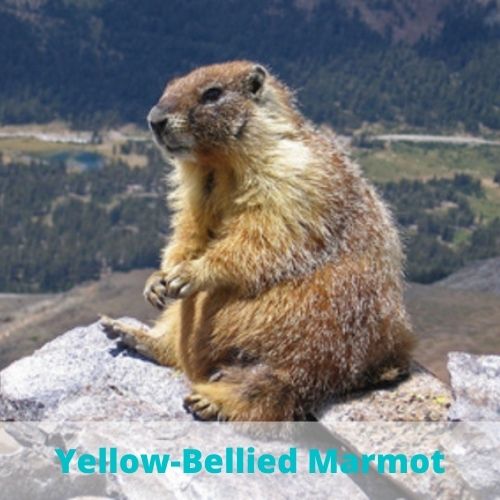
Marmots are middle-sized rodents that can be found in southwestern Canada and western U.S. A.
They are mammals and have grizzled brownish fur, yellow bellies, and white patches between eyes. They usually live 13-15 years.
Yellow-bellied marmots like warm, dry areas. They usually build their burrows in almost desert areas, open forests, rocky hills, and also in the mountains (but above the areas where trees grow).
Rocks do not only allow them to build solid burrows but also allow them to enjoy the sun while keeping an eye on predators.
Yellow-bellied marmots are terrestrial animals that are mainly active during the day. They feed mainly on the leaves, plants, grass, grains, fruits, legumes, and occasionally insects.
Yellow-bellied marmots live in colonies of approximately 10-12 individuals. There is one single dominant male that mates with one or several females.
As soon as the male wakes up from hibernation, he starts digging a burrow and looking for females to share it with.
Interesting facts about Yellow-Bellied Marmot
- Yellow-bellied marmots hibernate 7-8 months a year. While regular burrows are usually 1 meter deep, the burrows they use to hibernate can reach 5-7 meters deep.
- Yellow-bellied marmots use noises and body language to communicate with one another.
When alarmed by predators, they whistle and scream. They use tooth chattering as a threat.
Yellow-Bellied Weasel

The yellow-bellied weasel is a mammal that belongs to the Mustelidae family.
It can be found in Eastern and Central Africa and it inhabits pine forests at altitudes between 1,000 m and 2,000 m, coming down lower than 1,000 m in wintertime.
As its very name suggests, the yellow-bellied weasel has a yellow-coloured underbelly while the tail and the body are dark brown.
Yellow-bellied weasels are solitary hunters that feed on rodents, birds, and other small mammals.
Interesting facts about Yellow-Bellied Weasels
- Since they live at high altitudes and their habitats cannot be easily accessed for observation, not many details are known about their lifestyle.
- Since the yellow-bellied weasel not only has a lean build but also excellent hearing, sight, and smell, it is an outstanding hunter.
For instance, it is able to quickly track mice and rats and chase them even in their burrows. - Yellow-bellied weasels can be tamed and used to keep the rodents population under control within human structures.
Yellow-billed Hornbill
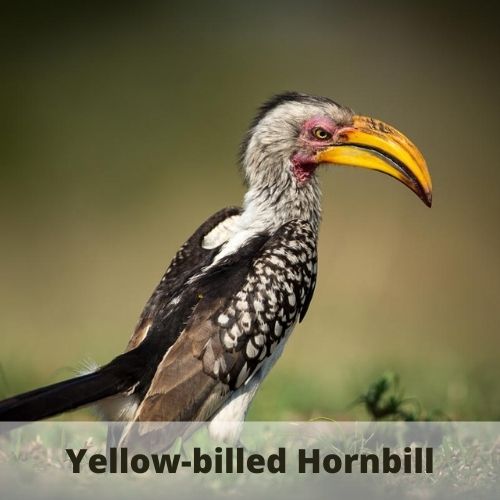
A medium-sized bird characterized by a long, curved, yellow beak, the yellow-billed hornbill can be found in southern Africa, living in dry, open savannas, acacia woodlands, broad-leaved woodlands.
It is active during the day and sleeps in trees to keep safe from predators. A generally solitary bird, the yellow-billed hornbill can live alone, in pairs, or small groups.
Yellow-billed hornbills live around 20 years in captivity. Their longevity in the wild is still unknown.
Yellow-billed hornbills feed mostly on arthropods (ex. termites, beetles, larvae, caterpillars, grasshoppers, etc.), but also scorpions, small mammals, nuts, fruits, or eggs from other species.
Southern yellow-billed hornbills don’t dig the ground, but they overturn debris in search of insects.
Yellow-billed hornbills use whistling, grunting, and caqueting to communicate.
Interesting facts about Yellow Billed Hornbills
- Due to their long, yellow beak, they are commonly called ‘flying bananas’.
- Couples are monogamous. There is a clear division of labour between females and males.
- Male beaks are approx. 9 cm long while female beaks are approx. 7 cm. That makes it easier to differentiate sexes.
- Yellow-billed hornbills and Dwarf Mongooses forage cooperatively: yellow-billed hornbills catch the prey that Dwarf Mongooses scratch from the ground.
To return the favour, hornbills keep an eye on overhead raptors and alert the mongooses if there is danger. - Yellow-billed hornbills are mostly sedentary and defend their territories.
- Once it mates, the male establishes a territory that it defends. They place their nests in natural cavities (trees, cliffs, etc.) Once the nest is built, the male places grass, leaves, and bark on its bottom.
Now it’s time for the female to seal herself in by building a wall at the entry. To ensure good air circulation, a vertical slit is left. The slit will also be used to pass food and expel droppings.
While the female is sealed inside the nest, she sheds her flight and feathers and regrows them. Females break out of the nest when the chicks are half-grown.
The chicks rebuild the wall and get fed through the slit by both parents until they are ready to fly.
Yorkshire Terrier

The Yorkshire Terrier (also commonly known as Yorkie) is among the smallest dog breeds.
This breed was developed in Yorkshire, England, during the 19th century. The breed is considered to descend from other terriers such as Maltese, Dandie Dinmont, black & tan Manchester, and Clydesdale (which is now extinct).
Its maximum size reaches 7 pounds (3.2 kg). Yorkshire Terriers have compact bodies, small heads, medium-length muzzles, and v-shaped ears.
One of this breed’s most notable features is its coat: fine, straight, and long. Its black, grey, and tan coat resembles human hair and requires careful and regular grooming.
Since Yorkies have long hair on the head, people often use ribbons to tie it thus making the dog look jaunty. Yorkshire Terriers usually live 12-15 years.
As far as their personality is concerned, Yorkies are playful, energetic, smart, curious, very protective, devoted, always fond of attention, and somewhat yappy. They often suffer from anxiety when they are left alone.
Interesting facts about Yorkshire Terrier
- Yorkshire Terriers have been used to develop other breeds (ex. the Silky Terrier)
- According to some reports, Yorkies were originally developed to catch vermin in underground tunnels and the rats that were infesting the mine shafts.
- The original Yorkies were larger than the ones we see today. They were miniaturized through selective breeding, turning them into fashionable home companions.
- During the late 1800s, the first Yorkies appeared In the United States as part of shows.
- Since the breed was originally developed as a working breed, Yorkies require both mental and physical stimulation (ex. indoor playing, long walks, etc.)
- Since their fur resembles human hair, Yorkies do not usually cause allergies.
Yellow-Eyed Penguin

One of the rarest penguin species in the world, the Yellow-eyed penguin is an endangered species native to New Zealand.
Also known as hoiho or yellow-crowned penguin, the Yellow-eyed penguin has a yellow head, pale yellow irises, a brownish-black throat and chin, dark grey back, white belly and chest, and a bright yellow band that runs from the eyes to the back of the head.
It is piscivorous, feeding mainly on cephalopods and fish. Yellow-eyed Penguins live up to 25 years, with males usually living twice as much as females.
Yellow-eyed Penguins are hunted by sea lions, cats, stoats, sharks, dogs, ferrets, seals, and barracoota.
Interesting facts Yellow eyed penguin
- The Yellow-eyed Penguin hunts offshore up to 25 km away. It is an excellent diver, reaching depths of up to 120 metres.
- Even though they forage relatively close to each other, Yellow-eyed Penguins build their breeding nests out of eyesight from any other nest.
- Yellow-eyed penguins form long-term pairs and they share responsibility when it comes to incubation and feeding the chicks.
- Yellow-eyed Penguins can be found on New Zealand’s $5 bill.
- Yellow-eyed Penguins may be the oldest penguin species.
Yellow-Footed Antechinus
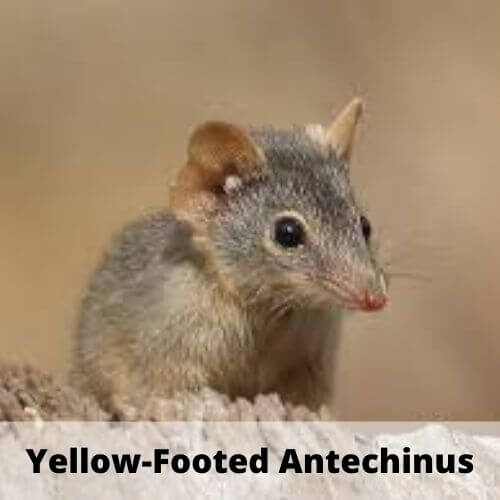
Also known as Mardo, the yellow-footed antechinus is a marsupial that can be found in Australia.
Its fur is grey on the shoulders and head and, as its name suggests, it turns to yellowish-brown on the rest of its body. The tail is brown and it is almost as long as its body (16 cm body, 14 cm tail).
It inhabits fallen logs and leaf litters in woodlands, forests, heath, swamps, and coastal plains.
The yellow-footed antechinus is particularly active during the day and feeds on eggs, nectar, lizards, and other invertebrates.
Interesting facts about Yellow Footed Antechinus
- These cute marsupials look very similar to rats and are sometimes called marsupial mice. However, they are the ecological equivalent of shrews, weasels, or mongooses.
- The yellow-footed antechinus has awkward breeding habits. The breeding season starts in August and lasts for 2 weeks.
During this time, males stop eating and they dedicate all their energy to finding a mate. Males die when the mating season ends, thus living less than a year. - Females give birth to 12 babies. The babies are raised in pouches.
Yucatan Squirrel
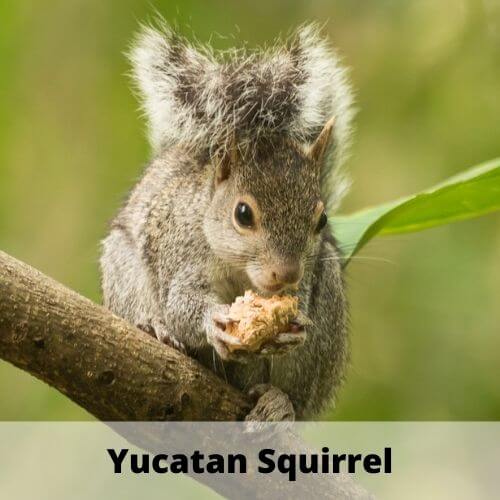
The Yucatan Squirrel is a rodent that belongs to the squirrel family. Originally known as the Yucatan gray squirrel, it can be found in the Yucatán Peninsula and the neighbouring areas.
The Yucatan squirrel inhabits dry and evergreen forests, as well as semiarid pine-oak woodlands. It can be found at altitudes below 750 metres.
It spends most of its time in trees and it is mostly active during the day. It mainly feeds on seeds, nuts, and soft fruits.
Yucatan squirrels use twigs and leaves to build their nests up in the trees. Their biggest enemies are snakes, birds of prey, primates, and wild cats and dogs.
Yunnan Hare
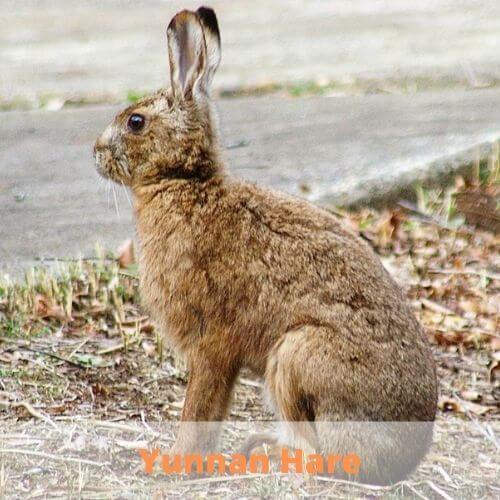
The Yunnan hare is a medium-sized mammal that belongs to the Leporidae family. Even if it is native to the Yunnan region in China, it has also been found in Myanmar.
Its pelage is long and soft and has a gray-brown or dark gray colour. The pelage on its belly is white. Yunnan hares prefer warm, wet habitats. They can be found in high montane meadows and shrubs.
They are herbivores, usually foraging on shrubs and forbs. Even if they are mainly active during the day, they also forage at night.
Interesting facts about Yunnan Hare
- Hunters have reported that females and males have different types of burrows. Males’ burrows are small, straight, and shallow. On the contrary, females’ burrows are larger and oval.
Yapok Opossum
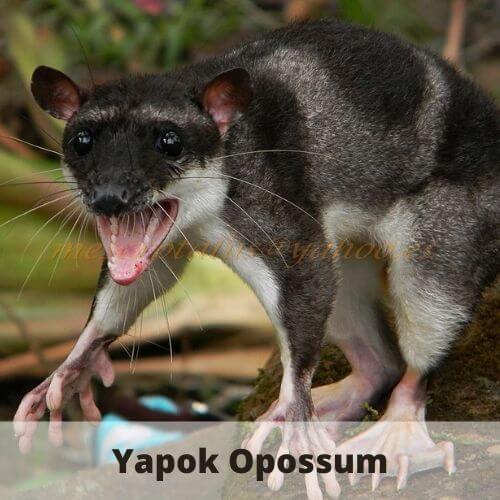
A semiaquatic marsupial belonging to the Didelphidae family, the Yapok Opossum can be found in and near lakes and freshwater streams that range from Mexico through South and Central America to Argentina.
The Yapok Opossum is not only the last living member of its genus but also the only living marsupial that presents pouches in both sexes. However, only the female’s pouch closes to keep offspring dry.
Their fur is dense and short, has a grayish-white and brown colour and it is water-repellent.
As far as it is known, the Yapok Opossum lives around 2-3 years. It feeds mainly on frogs, shrimp, crabs, fish, and other small aquatic animals.
Since they are aquatic animals, Yapok Opossums have broad, webbed hind-feet that help them move through the water.
Their long tails also aid in swimming. Their forefeet consist of long, naked fingers that they use to catch the prey.
Yapok Opossums are primarily nocturnal animals, but they also forage during the day.
Generally, they are solitary individuals. A typical familial group contains one male, one female, and their young.
Yapok Opossums live in relatively large burrows that they build just above the water level in small holes near the water or between tree roots. The burrows are built to sustain low water levels.
Sometimes, Yapok Opossums build diurnal nests near their dens that they use to rest. The nests are made of leaves and grass and are built on the ground.
Interesting facts about Yapok Opossum
- The mother’s pouch has a strong ring of muscle that makes it watertight. This way, the young remain always dry, even if the mother immerses in water. The male’s pouch is less watertight than the female’s.
- Under each eye, Yapok Opossums have tactile bristles and whiskers that function as sensory organs, helping them move through the water and detect prey and potential predators.
- Yapok Opossums also use their tails to carry or manipulate objects.
Yacare Caiman
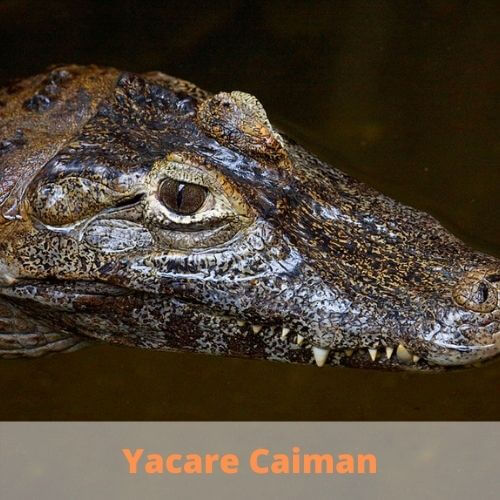
The Yacare caiman can be found in Central and South America. It inhabits the tropical forests of the Amazon Basin and it usually lives close to swamps, lakes, slow rivers, and slow streams.
Even though there is not much information available about its social behaviour, we know for sure that the Yacare Caiman is a fierce predator.
When hunting, it will lie still in the water and attack when its prey reaches the shore. Yacare Caimans are rather sedentary and are mainly active during the night.
It is known to be a solitary animal that generally gathers during the mating season. Yacare Caimans are excellent swimmers, using their tails to propel themselves.
The Yacare caiman is a carnivore, feeding mainly on fish (especially piranhas), reptiles, birds, and other small mammals.
Habitat destruction and illegal hunting are the biggest threats to the Yacare caimans’ survival.
Interesting facts about Yacare caiman
- The Yacare Caiman has outstanding eyesight and hearing.
- The Yacare caiman’s body is covered with hard scales that protect it like armour. Its skin is sometimes covered with pale spots and stripes that help it camouflage.
- The Yacare Caiman spends most of its time bathing in the sun.
- The female builds a mound nest that she will then use to lay 21 to 38 eggs. The nest’s temperature will determine the baby’s gender.
While low temperatures produce females, high temperatures will produce males. Once the eggs hatch, the young follow their mother in the water to learn how to swim. - The Yacare Caiman is also known as the ‘Piranha caiman’. This name is due to its unusual teeth display: the large teeth in the lower jaw sometimes protrude through the upper jaw.
Yuma Myotis
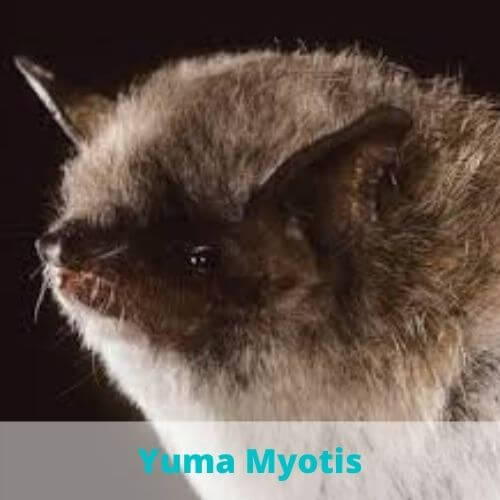
The Yuma myotis is a small vesper bat that can be found in western North America.
In the United States, the Yuma Myotis is abundant in all the states on the Pacific coast. Usually, its colour ranges from gray to brown with a paler shade of gray on the abdomen.
The Yuma Myotis roosts in caves, trees, mines, cliff crevices, underneath bridges, and buildings.
It usually inhabits lowlands close to standing water (ponds, lakes, etc.), and can be found in habitats that range from coniferous forests to arid scrubs.
When not close to water, they roost in attics, buildings, mines, and other similar structures.
The Yuma Myotis is active during the night and feeds on aquatic insects, moths, spiders, beetles, termites, leafhoppers, etc. It forages in the vegetation close to the water and above the water’s surface.
Interesting facts about Yuma Myotis
- After eating, the Yuma Myotis rests to digest the food.
- A roost may contain up to 10,000 individuals.
- They share their nursery roosts with other species. The air temperature in their nursery roosts can reach up to 40ºC.
Yellow-Footed Rock Wallaby

The yellow-footed rock-wallaby is a marsupial closely related to kangaroos, wallaroos, wallabies, and tree-kangaroos.
It is a pouched mammal that can be found in eastern South Australia, western New South Wales, and some portions of Queensland. It can live up to 10 years.
Yellow-footed rock wallabies have a distinctive fur: a mixture of brown, white, gray, and yellow or orange. This colours mix provides camouflage among the rocks.
They live in colonies that usually consist of a dominant male, a few sub-dominant males, breeding females, and offspring. The dominant male will force young males to leave the colony.
Yellow-footed rock wallabies can jump as far as 4 meters from one rock to another, thus moving easily around mountaintops, scaling cliffs, and climbing trees.
Interesting facts about Yellow-Footed Rock Wallabies
- As its very name suggests, this species prefers rough terrains and rocks. Hence, it’s not usually found near human habitation.
To protect themselves from the heat of the day, they find shelter in caves, cracks and crevices.
They usually come out of their shelters in the late afternoon to feed on vegetation. - Due to hunting and habitat alterations by other species (ex. goats, foxes, etc.), this species is currently listed as vulnerable.
- During hot summers, wallabies can drink a lot of water in a matter of minutes: over 10% of their bodies’ weight!
If you loved this article make sure to also check out these as well:

